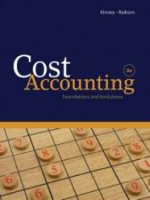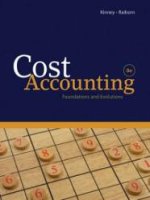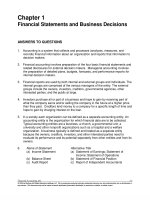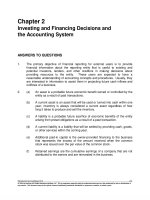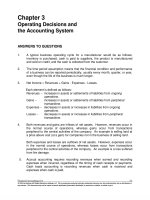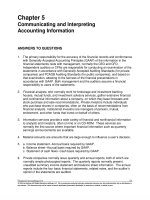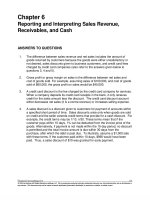Solution manual managerial accounting 8e by hansen mowen ch 16
Bạn đang xem bản rút gọn của tài liệu. Xem và tải ngay bản đầy đủ của tài liệu tại đây (240.14 KB, 34 trang )
To download more slides, ebook, solutions and test bank, visit
CHAPTER 16
LEAN ACCOUNTING, TARGET COSTING, AND THE
BALANCED SCORECARD
QUESTIONS FOR WRITING AND DISCUSSION
1. Lean manufacturing is an approach designed to eliminate waste and maximize
customer value. It is characterized by delivering the right product, in the right quantity,
with the right quality (zero-defect) at the exact time the customer needs it and at the
lowest possible cost.
needed; (3) Inventories of goods awaiting further processing or consumption; (4) Unnecessary processing; (5) Unnecessary movement
of people; (6) Unnecessary transport of goods;
(7) Waiting; and, (8) The design of goods and
services that do not meet the needs of the customer.
2. The five principles of lean thinking are: (1)
Precisely specify value by each particular
product; (2) Identify the "value stream" for
each product; (3) Make value flow without
interruption; (4) Let the customer pull value
from the producer; and (5) Pursue perfection.
8. A focused value stream is dedicated to one
product. It includes all the activities and
steps necessary to produce, deliver, and
service the product after it is sold. The resources, people, and equipment to accomplish this are all exclusive to the value
stream, making all the costs directly traceable to the product produced by the value
stream.
3. Two types of value streams are the order
fulfillment value stream and the new product
value stream. The order fulfillment value
stream focuses on providing current products to current customers. The new product
value stream focuses on developing new
products for new customers.
9. Facility costs are assigned using a fixed cost
per square foot( (total cost/total square feet).
If a value stream uses less square feet, it
receives less cost. Thus, the purpose of this
assignment is to motivate value stream
mangers to find ways to occupy less space.
As space is made available, it can be used
for new product lines or to accommodate increased sales
4. A value stream may be created for every
product; however, it is more common to
group products that use common processes
into the same value stream. One way to
identify the value streams is to use a simple
two-dimensional matrix, where the activities/processes are listed on one dimension
and the products on a second dimension.
5. The key factors in being able to produce low
volume products with great variety are lower
setup times and cellular manufacturing. Reducing setup times and using manufacturing
cells eliminates considerable wait and move
time so that cycle time is dramatically reduced.
6. Demand-pull means producing only the
products when needed and in the quantities
needed.
Demand-pull
systems
reduce/eliminate WIP and finished goods inventories. Inventories are the most significant source of waste in a manufacturing
firm.
7. Eight sources of waste are: (1) Defective
products; (2) Overproduction of goods not
547
10.
Units shipped are used to discourage the
production of excess inventories. It also encourages the reduction and elimination of
existing finished goods inventories. The unit
cost increases if more units are produced
than sold. The unit cost decreases if are
shipped than units produced.
11.
If the products in the value stream are quite
similar, then the average cost will approximate the actual unit product cost. If the
product mix is relatively stable over time,
then the average unit cost can be a good
signal of overall changes in efficiency within
the value stream.
12.
Value streams often have excess capacity.
In certain decisions, such as make or buy or
accept or reject special orders, the change
in profitability is the key factor in assessing
which way to go. In these cases, knowledge
To download more slides, ebook, solutions and test bank, visit
needed for the process, customer, and financial objectives.
of individual product cost is not needed and,
in fact, may be misleading.
13.
14.
15.
16.
17.
The lean control system uses a Box Scorecard that compares operational, capacity,
and financial metrics with prior week performances and with a future desired state.
Trends over time coupled with the expectation of achieving some desired state in the
near future is the means used to motivate
constant performance improvement. Thus,
the lean control approach uses a mixture of
financial and nonfinancial measures for the
value steam. The future desired state reflects targets for the various measures. Operational, nonfinancial measures are also
used at the cell level.
Life-cycle costing is measuring the costs
associated with a product for its entire life
cycle. Life-cycle management is managing
the activities during the development stage
to ensure the lowest total life-cycle cost.
Budgeting life-cycle costs can help managers
adjust the activities during the development
stage; furthermore, comparing actual lifecycle costs with budgeted costs should enable managers to improve life-cycle cost
management in the future using the feedback from actual results.
Target costing is a cost management method that is used to reduce costs to a level
that reflects a product’s functions and market demands and management’s return requirements. Costs are reduced to target by
product and process redesign activities.
Product redesign is aided by reverse engineering and value analysis.
The Balanced Scorecard translates an organization’s vision and strategy into operational objectives and measures for four
perspectives: financial, customer, process,
and learning and growth.
A strategy is the process of choosing the
market and customer segments, identifying
the critical internal processes, and selecting
the individual and organizational capabilities
548
18.
Lag measures reflect what has happened.
Lead measures reflect what may happen.
19.
A testable strategy is a set of linked objectives aimed at an overall goal that can be
restated into a sequence of cause-and-effect
hypotheses.
20.
Double-loop feedback is information that
deals with both the effectiveness of strategy
implementation and the validity of the assumptions underlying the strategy.
21.
The three strategic themes of the financial
perspective are revenue growth, cost reduction, and asset utilization.
22.
The five core objectives of the customer
perspective are market share, customer retention, customer acquisition, customer satisfaction, and customer profitability.
23.
The long-wave of value creation means
anticipating the emerging and potential
needs of customers and creating new products and processes to satisfy those needs.
The short-wave of value creation is producing and delivering existing products to customers.
24.
Cycle time is the length of time required to
produce one product; velocity is the number
of units that can be produced in a given period of time.
25. Manufacturing cycle efficiency is a ratio
computed by dividing the processing time by
the sum of processing time, move time, inspection time, and waiting time. The ideal is
to increase efficiency by reducing the nonvalue-added times of moving, inspection, and
waiting.
26.
Three objectives of the learning and growth
perspective are increase employee capabilities; increase motivation, empowerment,
and alignment; and increase information
systems capabilities.
To download more slides, ebook, solutions and test bank, visit
EXERCISES
16–1
1.
2.
3.
4.
5.
6.
7.
8. a
e
d
b
e
b
c
e
16–2
Value Streams:
A&D: All common processes
B&E: All common processes
C: Different from all other products
16–3
1.
Departmental times:
Processing time (10 × 30*)
Wait and move time
Total time
300 minutes
53 minutes
353 minutes
*The sum of the unit production times for each department
2.
Cellular times:
Unit
First
Second
Third
.
.
Tenth
Elapsed time
30 minutes
40
50
.
.
120 minutes
If the cell is continuously producing then the time is 100 minutes (10 × 10)
549
To download more slides, ebook, solutions and test bank, visit
16–3 Continued
3. Time saved = 353 – 120 = 233 minutes (253 minutes for the continuous case)
= 233/10 = 23.3 minutes per unit (25.3 for continuous)
16–4
1.
60 minutes/10 = 6 units per hour is the current production rate (10 minutes is
the bottleneck time—for the first department.
2. 10 minutes; the bottleneck sets the production rate
3. The minimum unit production time for any process within the cell must be 6
minutes. Thus, ways must be found to reduce the processing time for Mixing,
Heating, and Tableting to 6 minutes. Process redesign and product redesign
are possible ways to reduce the times.
16–5
1. Materials, people, equipment and other resources are dedicated to value
streams as far as possible. In some case, there may not be enough specialized
resources for each value stream. For example, the quality engineer is spread
out over several value streams. A portion of his salary (0.40 × $75,000 =
$30,000) would be assigned to the value stream. Facility costs are assigned by
obtaining a cost per square for the entire facility ($900,000/100,000 = $9.00 per
square foot) and then multiplying this by the square feet occupied by the value
stream: $9.00 × 10,000 = $90,000. This amount would be added to the
$1,800,000, to bring the total value stream cost to $1,890,000. If the MP3 value
stream could find a way to occupy less space (say 7,000 square feet) and do
the same tasks, they would receive an cost assigned of $63,000 ($9 ×
7,000).Thus, there is an incentive to use no more space than necessary. Thus,
the purpose of this assignment is to motivate value stream mangers to find
ways to occupy less space. As space is made available, it can be used for
new product lines or to accommodate increased sales.
2. The recommended size of a value stream is between 25 and 150 employees.
3. The most likely option to be exercised is to cross-train Mary so that she can
function in quality control, eliminating the need for the quality engineer to
share time with more than one value stream. It also allows productive use of
available capacity and will not increase the cost of the MP3 value stream, and
in fact, may decrease the cost when the partial services of the value engineer
are eliminated.
550
To download more slides, ebook, solutions and test bank, visit
4. Unit cost = $1,890,000/20,000 units = $94.50 per unit. This cost is very accurate
because virtually all of the costs are assigned using direct tracing. Causal
tracing is used for facility costs and quality engineering. Thus, this cost is a
good efficiency measure for the MP3 value stream and tracking it over time
will provide a measure of changes in efficiency.
16–6
1. First, calculate activity rates:
Cell: Driver is conversion time (in minutes):
$9,600/(600+1800) = $4 per minute
Engineering: Driver is Engineering hours:
$3,400/80 = $42.50 per eng. hr.
Testing: Driver is testing hours:
$3,000/80 = $37.50 per test hour
Next, calculate product costs:
Model A
Cell:
$4 × 600
$4 × 1,800
Engineering:
$42.50 × 15
$42.50 × 65
Testing:
$37.50 × 25
$37.50 × 55
Total
Units
Unit cost (cost/units)
Model B
$ 2,400.00
$ 7,200.00
637.50
2,762.50
937.50
$3,975.00
50
$79.50
2,062.50
$12,025.00
150
80.17
2. Average cost = $16,000/200 = $80. The average cost approximates the ABC
costs with very little error, suggesting that the two value stream products are
quite similar.
551
To download more slides, ebook, solutions and test bank, visit
16–7
1.
Sales (90 @ $40)
Cost of goods sold (90 @$20)
Gross profit
Week 1
$3,600
(1,800)
$1,800
Sales (100 @ $40)
Cost of goods sold (100 @$20)
Gross profit
Week 2
$4,000
(2,000)
$2,000
Sales (90 @ $40)
Cost of goods sold (90 @$20)
Gross profit
Week 3
$3,600
(1,800)
$1,800
2.
Week 1: Average cost = Value stream cost/units shipped
= $1,800/90 = $20
Week 2: Average cost = Value stream cost/units shipped
= $1,800/100 = $18
Week 3: Average cost = Value stream cost/units shipped
= $1,800/90 = $20
The average cost decreased with a drop in inventories and increased with an increase in inventories. The signal is consistent with the objective of reducing inventories.
3.
Week1:
Sales (90 @ $40)
Materials
Conversion cost
Value stream profit
Change in inventory
Gross profit
$3,600
(450)
(1,350)
$1,800
0
$1,800
Week 2:
552
To download more slides, ebook, solutions and test bank, visit
Sales (100 @ $40)
Materials
Conversion cost
Value stream profit
Change in inventory
Gross profit
$4,000
(450)
(1,350)
$2,200
(200)
$2,000
Week 3:
Sales (90 @ $40)
Materials
Conversion costs
Value stream profit
Change in inventory
Gross profit
$3,600
(500)
(1,500)
$1,600
200
$1,800
The value stream profit is highest in week 2 and lowest in week 3. The profit variability is directly tied to the ability of the stream to produce on demand. In
weeks 1 and 2, inventories are stable or decreasing. In week 3, the stream slipped
and produced more than demanded and so profits decreased. The change in inventory adjustment brings the value stream to the traditional measurement. When
the value stream achieves the ability to produce on demand, the two incomes will
be the same and any changes income will be from reductions in waste other than
inventories.
16–8
1. Seven nonfinancial measures (4 operational and three capacity)
2. Time-based: on-time delivery and dock to dock days; quality-based: firsttime through; efficiency: units sold per person and average cost. Lean
firms compete on the basis of these three dimensions. They strive to
supply the right quantity at the right price at the right quality at the time the
customer wants the product. To supply the quantity needed at the time
needed mandates shorter cycle times. Quality mandates zero defects and
lower prices mean that a lean firm must reduce its costs and become more
efficient.
3. The planned state sets targets for the various financial and nonfinancial
measures and thus encourages continuous and innovative improvements.
4. The value stream (processes within the value stream) possess a certain
amount of capacity based on resources employed. Value-added us of the
resources is productive use; using resources to produce waste is nonproductive use. Thus, all nonvalue-added activities are non-productive use of
553
To download more slides, ebook, solutions and test bank, visit
value-stream capacity. As waste is reduced, resources become available
for other productive uses.
5. As quality, time, and efficiency increase, we would eventually expect all of
this to convert into financial gains. Typically, what happens is that elimination of waste is first expressed as available capacity. Financial gains are
realized when the available capacity is either reduced by reducing resources needed or they are used elsewhere for other productive purposes.
16–9
1.
Desired profit = $50 × 1,500,000 = $75,000,000
2.
Projected profit = ($150 × 1,500,000) $225,000,000 − $180,000,000 =
$45,000,000
3.
Target cost = $150 – $50 = $100
Need to reduce costs by $20 per unit ($180,000,000 ÷ 1,500,000 = $120/unit;
$120 – $100 = $20/unit) or $30,000,000 ($20 × 1,500,000) for the target to be
met.
Three methods are available: reverse engineering, value analysis, and
process improvement. The first two methods are concerned with reducing
costs by improving product design. Reverse engineering may reveal more efficient design features that can be exploited, while value analysis should
show which product functions are worth keeping and which ones are worth
dropping or changing. Process improvement puts the company into the realm
of process value analysis where the emphasis is selecting only those activities that add value and eliminating the ones that do not.
4. It would be wise to include postpurchase costs in design decisions. Reducing
postpurchase costs reduces customer sacrifice and, therefore, increases customer value, creating a potential competitive advantage for a company. Including postpurchase costs in target costs makes less sense because postpurchase costs are incurred by the customer and not by the company.
554
To download more slides, ebook, solutions and test bank, visit
16–10
1.
If (a) employees are trained to improve their soldering capabilities, (b) the
manufacturing process is redesigned, and (c) the right suppliers are selected,
then the number of defective units produced will decrease; if the number of
defective units produced decreases, then customer satisfaction will increase;
if customer satisfaction increases, then market share will increase; if market
share increases then sales will increase; if sales increase, then profits will increase.
2.
Profits
Increase
FINANCIAL
CUSTOMER
PROCESS
Supplier
Selection
Customer
Satisfaction
Increases
Market
Share
Increases
Defects
Decrease
Redesign
Process
Soldering
Training
INFRASTRUCTURE
555
Revenues
Increase
To download more slides, ebook, solutions and test bank, visit
16–10 Concluded
3.
Each consequence of the if-then sequence (the “then” outcome) can be
tested to see if the outcome is as expected. For example, if workers are
trained to solder better, do defects actually decrease? If defects decrease, do
we observe an increase in customer satisfaction? Does market share then increase? Thus, the consequences are observable but only if they are measured. Of course, it should be mentioned that not only must outcomes be
measured but also those factors that lead to the outcomes (the performance
drivers). Was the process redesigned? How many hours of soldering training
are needed, and were they provided? Were suppliers selected so that we now
have a higher-quality circuit board? Note also that the number of defects acts
as both a lag measure and a lead measure. First, it measures the outcome for
training, supplier selection, and process redesign. Second, it also drives customer satisfaction (which must be measured by surveys).
Targets indicate the amount of performance driver input and the improvement
expected. For example, the company may budget 100 hours of soldering
training, 300 hours of supplier evaluation, and two new process changes, and
then expect a 50 percent reduction in the number of defects (the outcome).
Suppose that the outcome is only a 10 percent reduction in defects. Comparing the 50 percent to the 10 percent reduction achieved reveals a problem.
Double-loop feedback provides information regarding both the validity of the
strategy and the effectiveness of implementation. If the targeted levels were
not achieved for the performance drivers, then it is possible that the outcome
was not achieved because of an implementation problem. If, however, the targeted levels of the performance drivers were achieved, then the problem
could lie with the strategy itself. Maybe training to solder better has little to do
with reducing defects (it may not be as much of a problem as thought). Or,
perhaps the current suppliers are not really a root cause for the production of
defects.
556
To download more slides, ebook, solutions and test bank, visit
16–11
a.
Customer, Nonfinancial, Objective, External, Lag (Lead)
b. Process, Nonfinancial, Objective, External, Lag (Lead)
c.
Financial, Financial, Objective, Internal, Lag (Lead)
d. Financial, Financial, Objective, External, Lag (Lead)
e.
Learning and growth, Nonfinancial, Subjective, Internal, Lead
f.
Process, Financial, Objective, Internal, Lag (Lead)
g. Customer, Nonfinancial, Subjective, External, Lead (lag)
h. Process, Nonfinancial, Objective, External, Lag (Lead)
i.
Learning and growth, Nonfinancial, Subjective, Internal, Lead
j.
Customer, Nonfinancial, Objective, External, Lead (Lag)
k.
Financial, Financial, Objective, External, Lag (Lead)
Note: Attempting to place measures in lead and lag categories will likely provoke some discussion. Lead indicators make things happen—they are the
things that enable outcome measures to be achieved. Many—if not all—
measures may act as both lead and lag indicators. Pure lead measures are
most likely to be found in the learning and growth category, whereas pure lag
measures are most likely in the financial perspective category. It is very difficult to classify measures as lead or lag without knowing the underlying strategy. This is an important message of the exercise. For example, on-time delivery is both a lead and lag measure. As a lead measure, it may signal an increase in customer satisfaction as on-time delivery improves. On the other
hand, it may act as an outcome measure for a manufacturing cycle time
measure (as cycle time decreases, then on-time delivery increases). As a
second example, consider unit product cost. This is a lag indicator (e.g., a result of improving process efficiency), but it can also serve as a lead indicator
(e.g., if a unit cost reduction leads to a price decrease which, in turn, leads to
an increase in market share).
557
To download more slides, ebook, solutions and test bank, visit
16–12
1.
Theoretical rate = $1,350,000/300,000
= $4.50 per minute
Theoretical conversion cost per unit = $4.50 × 15
= $67.50
2.
Applied conversion cost per unit = $4.50 × 20 = $90
Note: 60/3 = 20 minutes used per unit
3.
An incentive exists to reduce product cost by reducing cycle time. For example, current cycle time is 20 minutes per unit. If cycle time could be reduced
to 15 minutes per unit, conversion costs would be reduced from $90 per unit
to $67.50 per unit, reducing the unit product cost by $22.50. Reducing cycle
time increases the ability to meet deliveries on time as well as increasing the
ability of the firm to respond quickly to customer demands.
16–13
1.
Velocity (theoretical) = 360,000/60,000 = 6 speakers per hour
Cycle time (theoretical) = 60 minutes/6 speakers = 10 minutes per speaker
2.
Conversion cost rate = $720,000/(60,000 × 60) = $0.20 per minute
Assignment per unit (theoretically) = $0.20 × 10 minutes = $2.00 or
$720,000/360,000 = $2.00
3.
Applied conversion cost = $0.20 × 40 minutes = $8.00
MCE = Theoretical time/Actual time = 10/40 = 0.25
4.
Wasted time = 40 – 10 = 30 minutes; Cost = $0.20 × 30 minutes = $6.00
558
To download more slides, ebook, solutions and test bank, visit
PROBLEMS
16–14
1.
Pizza: (3 × 30) + (7 × 30) = 300 slices/10 slices per pizza = 30 pizzas
Root beer: (3 × 30) + (2 × 30) = 150 glasses/5 glasses = 30 pitchers
Salads: (1 × 60) = 60 bowls.
2. Pizza ($10 × 30)
Root beer ($3 × 30)
Salad ($2 × 60)
Total cost
$300
90
120
$510
Average lunch cost = $510/60 = $8.50
3. Group (value stream) A:
Pizza: (3 × 30) = 90 slices/10 slices per pizza = 9 pizzas
Root beer: (3 × 30) = 90 glasses/5 glasses = 18 pitchers
Salads: (1 × 30) = 30 bowls
Pizza ($10 × 9)
Root beer ($3 × 18)
Salad ($2 × 30)
Total cost
$ 90
54
60
$204
Average lunch cost = $204/30 = $6.80
Group B:
Pizza: (7 × 30) = 210 slices/10 slices per pizza = 21 pizzas
Root beer: (2 × 30) = 60 glasses/5 glasses = 12 pitchers
Salads: (1 × 30) = 30 bowls.
Pizza ($10 × 21)
Root beer ($3 × 12)
Salad ($2 × 30)
Total cost
$210
36
60
$306
Average lunch cost = $306/30 = $10.20
Placing customers into groups based on similar consumption patterns is analogous to placing products in value streams based on usage of similar processes.
Assigning all the costs to the groups that relate to the groups is analogous to assigning to dedicating people, equipment and resources to a value stream.
559
To download more slides, ebook, solutions and test bank, visit
16-14 Concluded
Calculating cost per lunch customer is analogous to calculating a cost per unit of
product produced.
ABC cost is based on causal relationships:
Cost per slice of pizza = $10/10 = $1 per slice
Cost per glass of root beer = $3/5 = $0.60
Cost per bowl of salad = $2.00
Cost per customer A type (3,3,1) = ($1 × 3) + ($0.60 × 3) + ($2 × 1) = $6.80
Cost per customer B type (7,2,1) = ($1 × 7) + ($0.60 × 2) + ($2 × 1) = $10.20
The focused value stream produces accurate product costing assignments.
16-15
1.
Group (Light Eaters) A:
Pizza: (2 × 15) + (3 × 15) = 75 slices/10 slices per pizza = 8 pizzas
Root beer: (2 × 15) + (3 × 15) = 75 glasses/5 glasses = 15 pitchers
Salads: (1 × 30) = 30 bowls.
Pizza ($10 × 8)
Root beer ($3 × 15)
Salad ($2 × 30)
Total cost
$ 80
45
60
$185
Average cost $185/30 = $6.17
ABC cost is based on causal relationships:
Cost per slice of pizza = $10/10 = $1 per slice
Cost per glass of root beer = $3/5 = $0.60
Cost per bowl of salad = $2.00
Cost per A1 type (2,2,1) = ($1 × 2) + ($0.60 × 2) + ($2 × 1) = $5.20
Cost per A2 type (3,3,1) = ($1 × 3) + ($0.60 × 3) + ($2 × 1) = $6.80
560
To download more slides, ebook, solutions and test bank, visit
16-15 Concluded
Group (Heavy Eaters) B:
Pizza: (6 × 15) + (7 × 15) = 195 slices/10 slices per pizza = 20 pizzas
Root beer: (3 × 15) + (2 × 15) = 75 glasses/5 glasses = 15 pitchers
Salads: (1 × 30) = 30 bowls.
Pizza ($10 × 20)
Root beer ($3 × 15)
Salad ($2 × 30)
Total cost
$200
45
60
$305
Average cost $305/30 = $10.17
ABC cost is based on causal relationships:
Cost per slice of pizza = $10/10 = $1 per slice
Cost per glass of root beer = $3/5 = $0.60
Cost per bowl of salad = $2.00
Cost per B1 type (6,3,1) = ($1 × 6) + ($0.60 × 3) + ($2 × 1) = $9.80
Cost per B2 type (7,2,1) = ($1 × 7) + ($0.60 ×2) + ($2 × 1) = $10.20
Using the ABC costs as a benchmark, the Group B value stream is a better similarity grouping than Group A. The groups are analogous to value streams
and the assignment of pizza, root beer, and salads to each group is analogous
to the assignment and dedication of people, equipment, and resources to value streams. The costing analogies are obvious.
2. The extra capacity created by this reduction is 1 × 30 = 30 slices of pizza and
1 × 30 = 30 glasses of root beer. The four guest program will require (5 × 2) +
(6 × 2) = 22 slices of pizza and (2 × 2)+ (1 × 2) = 7 glasses of root beer. No additional cost is required (relative to the original arrangement) for pizza and root
beer; however, four extra salads would be needed and would cost an extra
$8.00 or $2.00 per guest. In a manufacturing environment, as waste is eliminated from the value streams, extra capacity exists. This extra capacity can
be used productively to increase value-stream profitability. For example, a
special order may be offered and if there is unused capacity in the value
stream, the only extra cost may be the cost of materials. Thus, if the price is
above the cost of materials, then accepting the order will increase valuestream profitability (in the short run)
16–16
561
To download more slides, ebook, solutions and test bank, visit
1. The operational performance measures that improved for the first six months
all have to do with improving time-based performance. On-time delivery and
dock-to-dock days showed dramatic improvements, reflecting the increased
ability of the firm to produce on demand. From the capacity measures, we see
that the ability to produce on demand has created additional available capacity
in the value stream. For the second six months, the focus has been on improving quality. FTT improved form 60% to 90 %, a dramatic increase in quality. For
example, eliminating scrap may explain why the materials cost dropped, giving the increase in ROS that did occur. The improvements have eliminated
waste and increased the amount of available capacity. The implications are
profound. The company can produce higher quality products more much more
rapidly. This will enable the company to produce the kind of products demanded by customers, in the quantities needed, and delivered when they need
them. This should begin to translate into increased sales and improved financial performance. The stage is now set.
2. The constant sales per person coupled with constant total sales, suggest that
the head count has not been reduced. More resources are available for use by
the value stream as reflected by the increase in available capacity. The fact
that financial performance has not improved dramatically is likely attributable
to the fact the company is maintaining the same level of resources in the value
stream. Eliminating these resources is one way to improve financial performance. However, a more preferable approach is to find ways to use them productively. New products and expanded production (which may occur because
of increased quality and improved cycle time) are much better ways of improving financial performance.
3. Accepting the order only promises a contribution of $10,000 or an ROS of 10%,
using the traditional standard cost. However, the value stream has 50% available capacity, suggesting that the order could easily be accepted (the value
stream is currently producing $800,000 of sales output) without causing any
increase in the conversions cost already being incurred. The only incremental
cost would be the materials cost of $30,000. Thus, value stream profitability
would increase by $70,000 and sales by $100,000. ROS = $330,000/900,000 =
36.67%, a hefty increase in ROS from this one order.
562
To download more slides, ebook, solutions and test bank, visit
16–17
1.
2007
2008
a. 192,000/80,000 = 2.4/hour (velocity)
60/2.4 = 25 minutes (cycle time)
2.4/hour
25 minutes
b. 152,000/80,000 = 1.9/hour (velocity)
60/1.9 = 32 minutes* (cycle time)
176,000/80,000 = 2.2/hour
60/2.2 = 27 minutes*
c. N/A
($20 – $10)/$20 = 50%
d. 152,000/80,000 = 1.9
176,000/80,000 = 2.2
e. 20,000/200,000 = 10%
16,000/200,000 = 8%
f. N/A
($200 – $250)/$250 = (20%)
g. N/A
(6 – 3)/6 = (50%)
h. 9,000/152,000 = 5.9%*
4,000/176,000 = 2.3%*
i. 4,000/152,000 = 0.026/unit*
16,000/176,000 = 0.091/unit*
j. 200 hours
800 hours
k. $300
$280
l. 2 × 40 = 80
6 × 40 = 240
m. ($300 × 4,000)/($300 × 152,000)
= 2.63%*
($280 × 16,000)/($280 × 176,000)
= 9.1%*
n. 20%
176,000/780,000 = 22.6%**
o. N/A
[($280 × 176,000) – ($300 ×
152,000)]/($300 × 152,000) = 8.1%*
*Rounded
**152,000 ÷ 20% = 760,000 + 20,000 = 780,000
563
To download more slides, ebook, solutions and test bank, visit
16–17 Continued
2.
Strategic Objectives
Measures
Financial:
Reduce unit cost
Develop new customers
Increase total revenues
Unit cost
New customers per unit sold
Percentage change in revenues
Customer:
Reduce customer
sacrifice
Price/Unit
Postpurchase costs
Increase customer
acquisition
Number of new customers
Increase market share
Percentage of market
Process:
Decrease process time
Cycle time/Velocity
Decrease defective units
Number of defects
Number of scrapped units
Decrease inventory
Days of inventory
Learning and Growth:
Increase employee
capabilities
Output per hour
Training hours
Suggestions
All measures have shown improvement over the two-year period. This provides evidence of the strategy’s viability, assuming that the measures are tied
to the strategy as they appear to be. What is lacking are the targets for the
various measures. Knowing the targets for the two-year period would significantly enhance the value of the feedback. It is important to emphasize that
comparing targets to actuals allows for an assessment both of implementation success and strategy viability (double-loop feedback).
564
To download more slides, ebook, solutions and test bank, visit
16–17 Concluded
3.
It is important to understand that one cause can have more than one effect
and that an effect can have more than one cause. Because of this, a strategy
can have several cause-and-effect branches. Based on the available information, we can express the strategy as follows:
If training is increased, then employee productivity and participation will increase; if employee productivity and participation increase, then product
quality and process time will improve; if process time decreases and if the
product quality improves, then inventory will decrease and costs will decrease (including postpurchase costs); if inventory decreases, then costs will
decrease; if costs decrease, then customer sacrifice decreases (selling prices
and postpurchase costs lowered); if selling prices and postpurchase costs
are lowered, then the number of customers can be increased; if the number of
customers increases, then market share will increase; if market share increases, then revenues will increase.
The measures reveal a lot about the strategy; in fact, if the measures are
properly specified, they should tell the whole story of the strategy. The measures allow us to infer the strategic objectives and the underlying relationships
of these objectives.
Market share is an example of a measure that acts as both a lead and a lag
measure. It acts as an outcome variable because it is a consequence of other
performance drivers such as selling prices and postpurchase costs, but it is
also a lead measure for revenues. Hours of training is a lead measure only
(for this example), and revenues is a lag measure only.
565
To download more slides, ebook, solutions and test bank, visit
16–18
1.
Setup
Materials handling
Inspection
Customer complaints
Warranties
Storing
Expediting
Total
$125,000
180,000
122,000
100,000
170,000
80,000
75,000
$852,000
Units produced and sold
÷120,000*
Potential unit cost reduction
$
7.10
*$1,920,000/$16 (total cost divided by unit cost)
The consultant’s estimate of cost reduction was on target. Per-unit costs can
be reduced by at least $7, and further reductions may be possible if improvements in value-added activities are possible.
2.
Target cost to maintain sales = $14 – $4 = $10
Target cost to expand sales = $12 – $4 = $8
Current cost = $16
Cost reduction to maintain = $16 – $10 = $6
Cost reduction to expand = $16 – $8 = $8
3.
Total potential reduction:
$ 852,000 (from Requirement 1)
150,000 (by automating)
$1,002,000
Units
÷ 120,000
Unit savings
$
8.35
Costs can be reduced by at least $7, enabling the company to maintain current market share. Further, if all the nonvalue-added costs are eliminated,
then the cost reduction needed to increase market share is also possible.
4.
Current:
Sales
Costs
Income
$ 2,160,000 ($18 × 120,000 units)
(1,920,000)
$ 240,000
566
To download more slides, ebook, solutions and test bank, visit
16–18 Concluded
$14 price (assumes that current market share is maintained):
Sales
Costs
Income
$1,680,000 ($14 × 120,000 units)
(918,000) ($7.65* × 120,000 units)
$ 762,000
$12 price:
Sales
Costs
Income
$ 2,160,000 ($12 × 180,000 units)
(1,377,000) ($7.65* × 180,000 units)
$ 783,000
*$16 – $8.35 = $7.65
The $12 price produces the greatest benefit.
16–19
1.
Current cost per unit = $12,800,000/20,000
= $640
Current profit per unit = $720 – $640
= $80
Target cost (C) to maintain current profit and expand market share:
$624 – C = $80
C = $544
2.
Nonvalue-added costs:
Materials (400,000 – 380,000)$21
Labor (96,000 – 91,200)$12.50
Setups (6,400 – 0)$75
Materials handling (16,000 – 0)$70
Warranties (16,000 – 0)$100
Total
Units produced and sold
Unit nonvalue-added cost
$ 420,000
60,000
480,000
1,120,000
1,600,000
$3,680,000
÷ 20,000
$
184
Current cost less nonvalue-added cost:
$640 – $184 = $456
This is much less than the target cost of $544 Thus, achieving target cost is
possible. How quickly the cost reductions can be achieved is another matter.
As CEO, I would attempt to reduce the nonvalue-added costs quickly by implementing lean manufacturing methodologies. I would also lower the price to
567
To download more slides, ebook, solutions and test bank, visit
$624 by year end and seek to take advantage of the increased market share—
even if it meant a short-term reduction in profits.
16–20
1.
Good life-cycle costing and life-cycle management require tracing development and logistics costs to individual products. The company should abandon the traditional distinction of product and period costs. While this distinction may work well for external reporting, a more comprehensive view is
needed for managerial product costing.
Also, because most of the costs are committed during the development
stage, it is critical that the design engineers know what drives product costs.
An activity-based management system is essential for life-cycle cost management.
2.
Revised income statements:
Sales
Cost of goods sold
Gross margin
Traceable expenses:
R&D
Marketing
Life-cycle income
Return on sales
Product A
$ 4,000,000
2,000,000
$ 2,000,000
Product B
$5,000,000
2,500,000
$2,500,000
Total
$ 9,000,000
4,500,000
$ 4,500,000
(1,200,000)
(575,000)
$ 225,000
5.6%
(800,000)
(575,000)
$1,125,000
22.5%
(2,000,000)
(1,150,000)
$ 1,350,000
15%
Based on the revised income statements, Product B is an attractive investment according to the 20 percent criterion.
568
To download more slides, ebook, solutions and test bank, visit
16–20 Concluded
3.
The target cost for A is $3,200,000 ($4,000,000 – $800,000); for B it is
$4,000,000 ($5,000,000 – $1,000,000). There is no need to reduce costs for
Product B—it already meets the target cost criterion ($3,875,000 is less than
$4,000,000). Product A, however, does not. Its costs are $3,775,000. Thus,
costs must be reduced by $575,000 ($3,775,000 – $3,200,000).
Activity analysis can help by identifying the activities associated with Product
A and the cost drivers that are associated with these activities. This information may help design engineers to redesign Product A so that it does not
consume as many resources over its life cycle. The information may also be
useful in helping redesign the processes used for producing and selling
Product A.
The ability to influence life-cycle costs is primarily available during the development stage. More than 90 percent of a product’s costs are committed during this stage, and very little can be done to alter the total cost by the time
production begins. Thus, it makes sense to focus on managing activities during the development stage.
4.
Postpurchase costs can be large and play a significant role in a customer’s
product purchase decision. Boyce Products strives to create a long-term
competitive advantage. Managing activities so that whole-life costs are reduced can help achieve this objective. Managers must balance whole-life
costs with other factors such as product performance, reliability, innovativeness, and durability.
569
To download more slides, ebook, solutions and test bank, visit
16–21
1.
Velocity (theoretical) = 180,000/60,000 = 3 heaters per hour
Cycle time (theoretical) = 60 minutes/3 heaters = 20 minutes per heater
2.
Conversion cost rate = $1,800,000/(60,000 × 60) = $0.50 per minute
Assignment per unit (theoretically) = $0.50 × 20 minutes = $10.00, or
$1,800,000/180,000 = $10.00
3.
Applied conversion cost = $0.50 × 30 minutes = $15.00
If cell managers are rewarded for lowering product cost, then one way product cost can be lowered is by decreasing the time to produce one unit of
product. For example, if the time is decreased from 30 minutes to 25 minutes,
then the conversion cost assigned would be $12.50 ($0.50 × 25), saving $2.50
per unit. Of course as cycle time decreases, delivering on time should also
improve.
4.
MCE = Theoretical time/Actual time = 20/30 = 0.67
Wasted time = 30 – 20 = 10 minutes; Cost = $0.50 × 10 minutes = $5.00
5.
In the advanced manufacturing environment, firms need to compete on the
basis of time and cost. These measures support these objectives. The goal is
to decrease cycle time (increase velocity) by eliminating nonvalue-added
time. As nonvalue-added time is reduced, MCE increases, and the conversion
cost assigned per unit decreases. Also, as MCE increases, nonvalue-added
time drops, and nonvalue-added costs decrease, yielding a lower-cost product.
570
To download more slides, ebook, solutions and test bank, visit
16–22
1.
MCE = 45.0/(45.0 + 3.0 + 7.5 + 12.0 + 36.0 + 46.5)
= 0.30
2.
Lean improvements improve the manufacturing process by changing the way
things are done—by improving time, quality, and efficiency. This is done by
incremental or dramatic improvements in processes. Rearranging work flow,
reducing scrap and defective units, implementing cellular manufacturing, and
JIT purchasing, are among the approaches taken. Process improvement and
innovation require a thorough understanding of the activities that define the
processes. Identifying the root causes (driver analysis) helps a manager understand how processes can be improved. Activity analysis adds to this understanding by identifying activities and assessing their value content. Finally,
performance measures that reflect quality, time, and efficiency are used to
measure progress in improving processes. For example, MCE is a measure of
the value-added content as a percentage of total activity performance. As the
value-added content increases, MCE should increase.
3.
MCE is a lag measure. To reduce MCE, as indicated in Requirement 2, the
process must be improved. Performance drivers would include hours of quality training (this should reduce inspection and rework time), suggestions per
employee (this could reveal ways to reduce wait time, for example), and realtime feedback capabilities (this could decrease wait and storage time).
571
